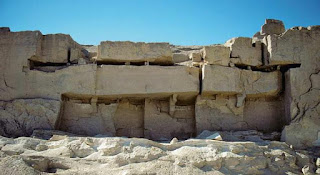The quanying of stone in the Nile Valley began at least as early as 40,000 years ago, when the Middle Palaeolithic inhabitants of Middle Egypt were quarrying and working cobbles of chert along the limestone ten-aces on either side of
the Nile. The earliest Palaeolithic chert quarries consisted of pits and trenches for surface extraction, but there are Upper Palaeolithic quarries at Nazlet Khater 4, on the western bank of the Nile, midway between Asyut and Sohag, which include vertical shafts and subterranean galleries (providing a foretaste of the quarrying methods of pharaonic times). The excavations at^Nazlet Khater 4 yielded many large hammerstones, used for the roughest stages of quarrying, as well as several of the picks used for finer work, which were carved from the horns of the gazelle and hartebeest.
Egyptian exploitation of the minerals in the cliffs and deserts on either side of the Nile Valley, and in the Sinai Peninsula, can be traced back to prehistoric times, with some of the earliest known items of jewelry made from
Eastern Desert carnelian and sard. Copper slag is known from the vicinity of the
Predynastic mines at Bir Nasib in southern Sinai, and turquoise miners were likely exploiting the nearby region of Serabit el-Khadim in the Chalcolithic period. The prehistoric workings were relatively small in scale compared with the massive royal expeditions that were sent to Sinai and Nubia during the first two dynasties. Some of the inscriptions and graffiti associated with the mining and processing sites provide information on the dates of the expeditions, lists of various types of workmen, and—in rarer instances—detailed narrative accounts of specific expeditions.
A great deal of archaeological and textual information has survived concerning mining expeditions in pursuit of building stone, copper, gold, turquoise, malachite, and a variety of other gemstones. Copper mining and smelting sites included Wadi Dara, Buhen, and Qubban, while numerous pharaonic gold-mining sites in the Eastern Desert of both Egypt and Nubia have been identified and surveyed during the 1980s and 1990s. Turquoise was mined at Wadi Mughara and Serabit el-Khadim, amethyst at Wadi el- Hudi and Gebel el-Asr (the so-called Khephren diorite quarries), galena at Gebel el-Zeit, and natron at the Wadi Natrun. The rough limestone for the interiors of pyramid complexes and
mastabas in the
Memphite necropolis was obtained from local quarries, while the much finer material for the outer casing of pyramids was quar- ried at Tura and Ma'sara on the opposite side of the Nile. Most of the sandstone for the temples at Thebes and other Upper Egyptian towns was obtained from the Gebel es-Silsila quarries, midway between
Luxor and
Aswan.
Recent Pages:


